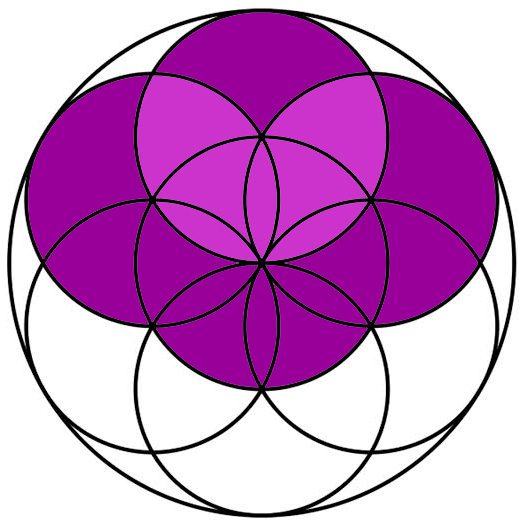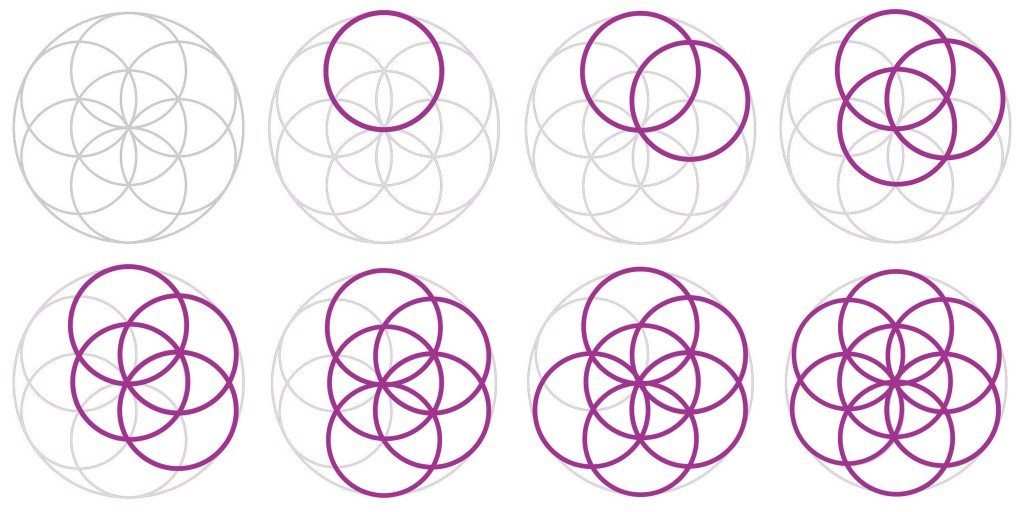What is the “Seed of Life”?
The “Seed of Life” is a contemporary name for an ancient geometric figure. It consists of seven overlapping circles with the same diameter. Six of them are regularly spaced within the seventh, producing a rosette with eighteen lens shaped petals: six smaller ones inside and twelve larger ones outside.
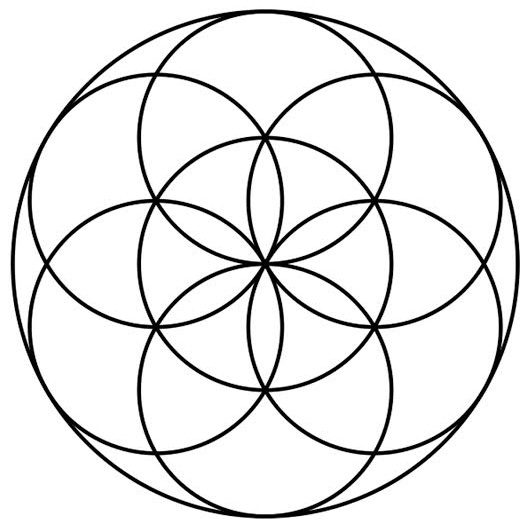
This figure can be replicated in six different directions, creating an interlocking net of circles and rosettes. A version constructed from nineteen circles is known today as the “Flower of Life”.
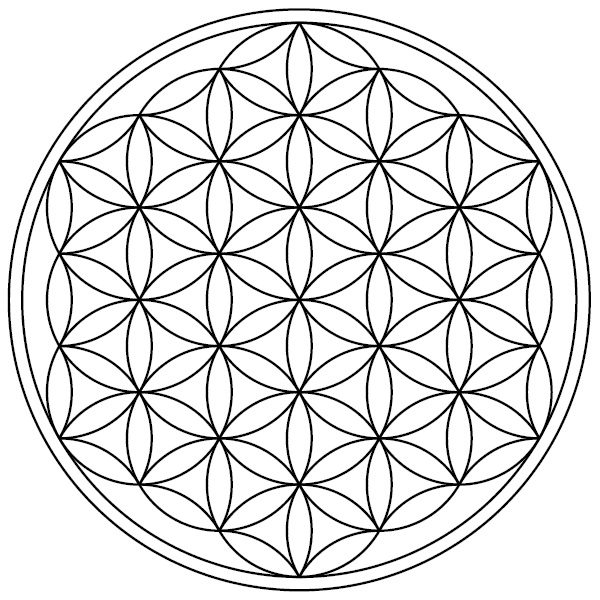
The names “Seed of Life” and “Flower of Life” are modern, popularized by the author Drunvalo Melchizedek in his workshops and books on sacred geometry since the mid 1980’s. He attributes these teachings to his angelic guides and a spiritual master related to the Egyptian deity Thoth, the patron of communication, wisdom, and science.
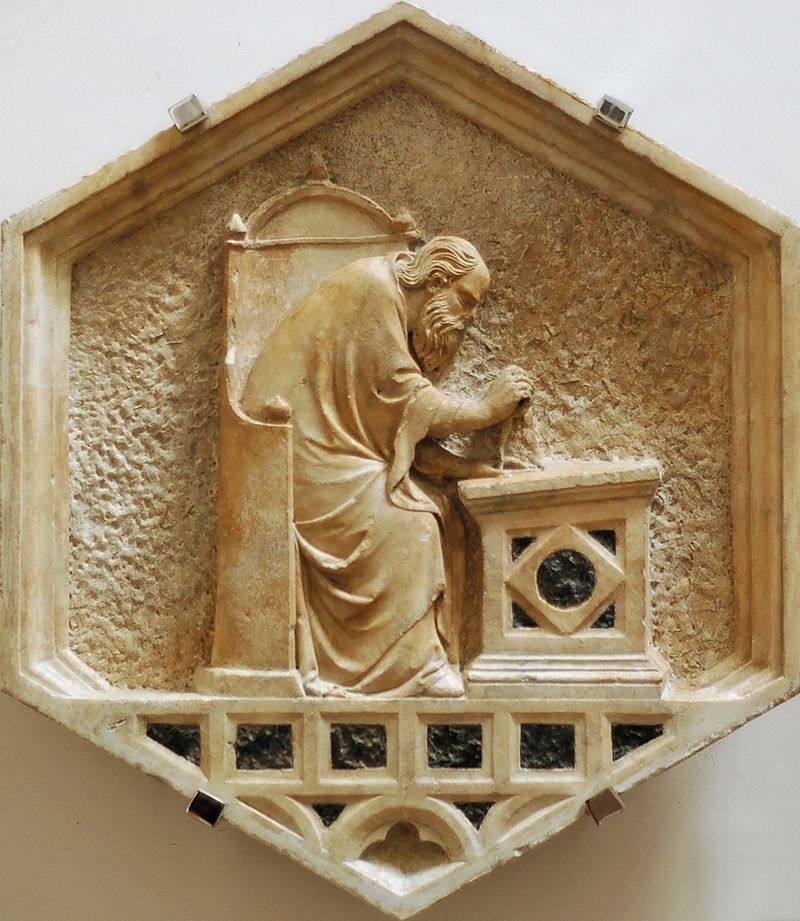 (A 14th century hexagonal panel of Euclid by Nino Pisano. As the “father of geometry”, Euclid is representing Architecture in a sculptural series of the Liberal Arts. He is depicted using a drawing compass at a workbench. Image Source: Public domain, Wikimedia Commons.)
(A 14th century hexagonal panel of Euclid by Nino Pisano. As the “father of geometry”, Euclid is representing Architecture in a sculptural series of the Liberal Arts. He is depicted using a drawing compass at a workbench. Image Source: Public domain, Wikimedia Commons.)
How were geometric figures constructed historically?
These rosettes comes from a long tradition of making geometric figures by hand.
The traditional tools of geometry are the straightedge and the compass, an instrument with two movable legs used to make circles. Compass drawn circles can be used to map out regular polygons like the square. The classic example is using two overlapping circles of equal diameter, the perimeter of each circle aligned to the center of the other, to create an equilateral triangle.
This is the first proposition of Euclid’s Elements, the foundational text of geometry since the 3rd century BCE. As the regular polygon with the smallest number of points, the triangle was seen as the first shape. Circles and arcs are similarly used to construct other geometric figures, like the pentagon.
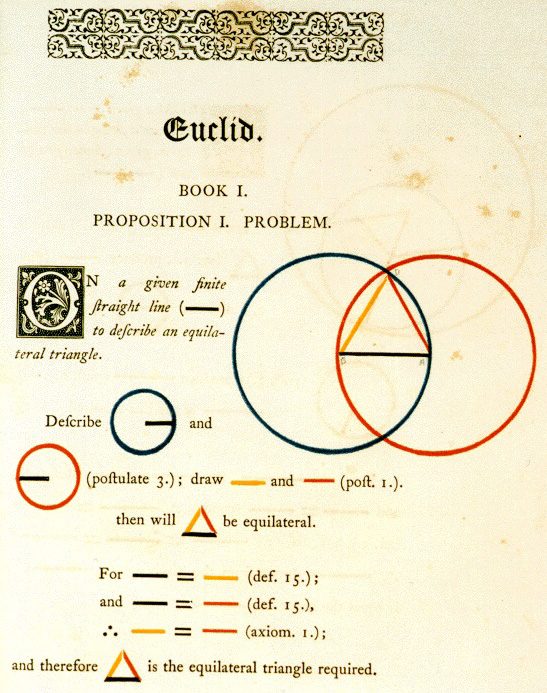
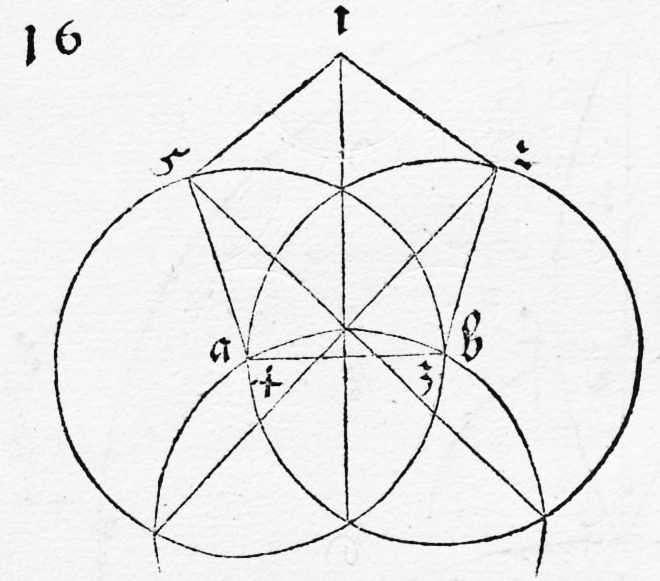 (Above: A mid 19th century illustration of Euclid’s first proposition by Oliver Byrne. Below: A 16th century illustration by Albert Dürer showing the construction of a pentagon with a compass and straightedge. Image Source: Public domain, Wikimedia Commons.)
(Above: A mid 19th century illustration of Euclid’s first proposition by Oliver Byrne. Below: A 16th century illustration by Albert Dürer showing the construction of a pentagon with a compass and straightedge. Image Source: Public domain, Wikimedia Commons.)
How is the Seed of Life created?
The Seed of Life is also created by overlapping circles of the same diameter (purple), creating a pointed oval between them (pink).
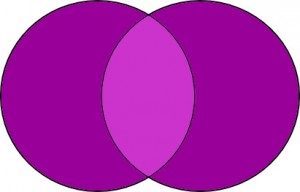
Focus on the top circle of the Seed of Life. Its outer edge rests on the center of its two direct neighbors and the central circle (all dark purple), creating three areas of overlap (pink). (The horizontal one is more difficult to see because it covered up by the crossing of the two vertical ones.) This arrangement is found in all six of the outer circles, while the seventh overlaps them all.
Image Source: Adaptation of a public domain image, Wikimedia Commons.)
The Seed of Life is easily constructed with a compass. Make a circle. Measure the circle with the compass to keep the same diameter. Create a second circle, placing its outer edge at the center of the first one. Make a third circle, aligning it to both circles. Then continue this pattern until you return to the original circle.
 Image Source: Adaptation of a public domain image, Wikimedia Commons.)
Image Source: Adaptation of a public domain image, Wikimedia Commons.)
Additional figures can be created by repeating or cropping the basic form. The rosette can be expanded in six different directions, creating a continuous network of intersecting circles with six lenses. This can be repeated infinitely or stopped after filling a certain area. The figure we call the “Flower of Life” today is a symmetrical network made from 19 circles.
Finally the inner circle may be used by itself, with or without additional lens shaped petals from neighboring circles in the net along its outer edge.
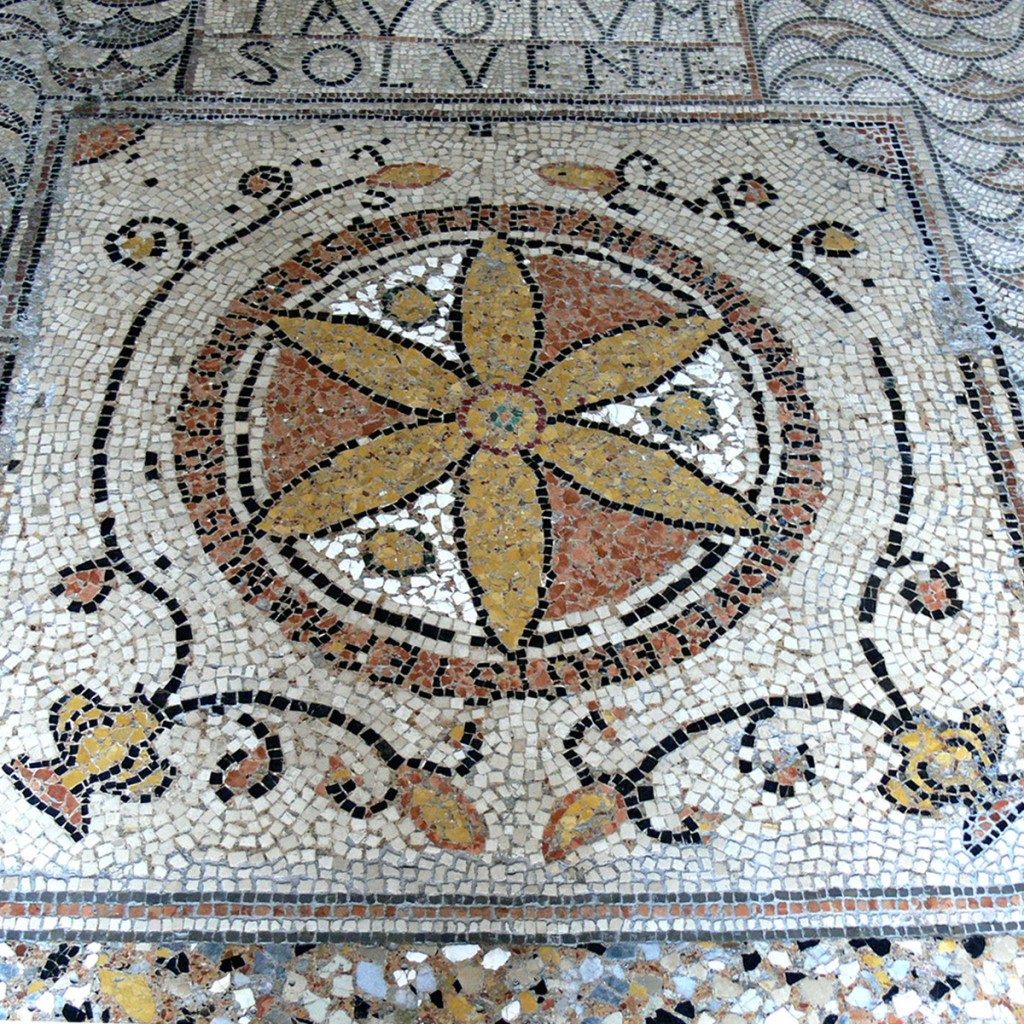
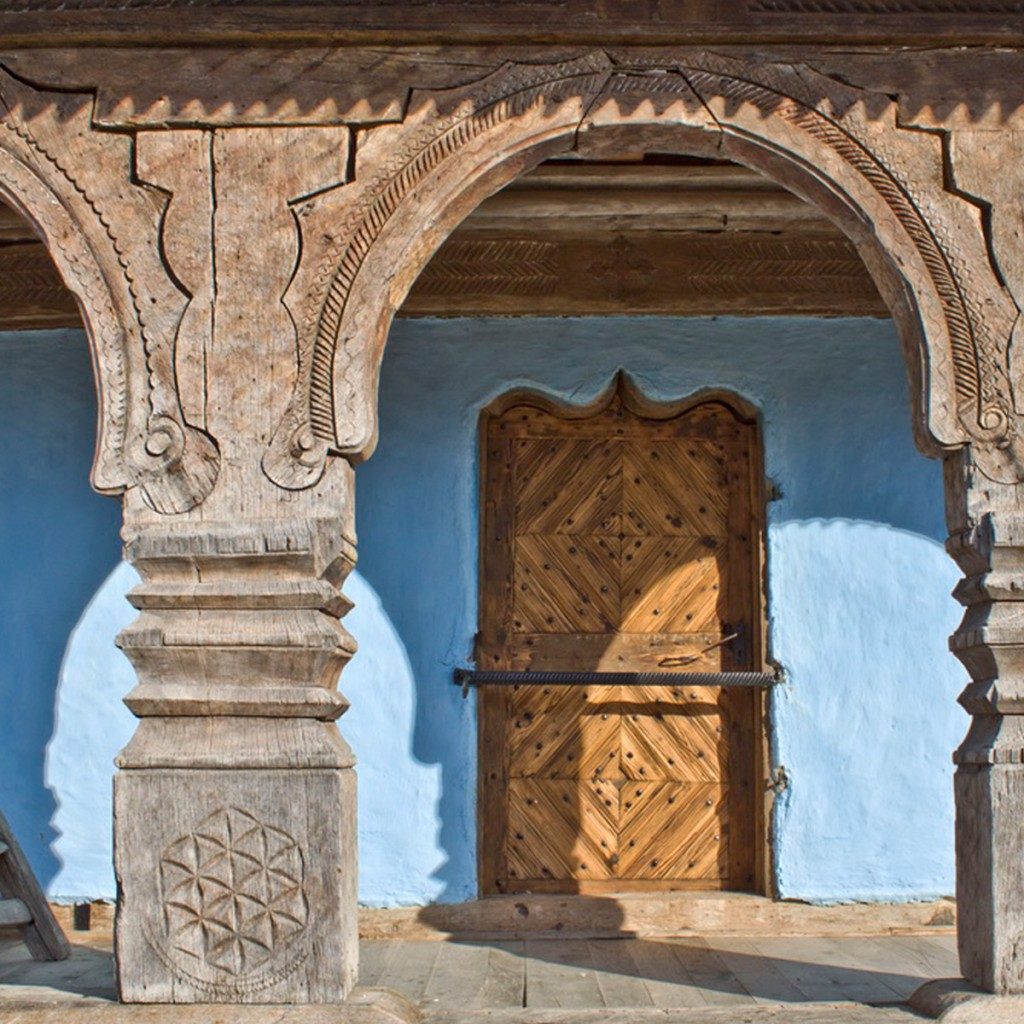 (Above: 6th century Italian mosaic with the six petal rosette as a flower, among other botanical motifs. Below: Interlocking rosettes as a door decoration on a 19th century wooden church in Lozna, Romania. Image Source: Public domain, Wikimedia Commons.)
(Above: 6th century Italian mosaic with the six petal rosette as a flower, among other botanical motifs. Below: Interlocking rosettes as a door decoration on a 19th century wooden church in Lozna, Romania. Image Source: Public domain, Wikimedia Commons.)
What does the Seed of Life mean?
Although the names “Seed of Life” and “Flower of Life” are contemporary, the geometric figures themselves have a long history. They are first documented in the ancient Near East, during the second millennium BCE. Despite their age and cross cultural use, we know surprisingly little about their traditional names or meanings:
1: A Flower: As the name rosette (French, “little rose”) implies, the figure resembles a flower. A tradition of using geometrically stylized flowers, leave, and branches as decorative elements originated in Mesopotamia and continues to be used today.
2: The Sun: The rosette has been used to represent the Sun, with the petals as rays. The Sun has a close association with the number six. While it has four stops during its daily motion (east at dawn, south at noon, west at dusk, north at night), it has six on its yearly journey. It rises and sets at its furthest north during July solstice, furthest south during December solstice, and rises due east and sets due west during both equinoxes.
3: Spiritual Protection: Several cultures believe the rosette is apotropaic, used to avert bad luck. The central six petals signify blessings in Pennsylvania Dutch hex signs. Likewise hexagonal geometric figures, including those we call the Seed of Life and Flower of Life, were used in Eastern Europe as “thunder marks”. Associated with Perun, the Slavic equivalent of the Norse Thor, they were carved on homes to protect from dangers like lightning.
We do know that the geometric rosette was used extensively as a template for constructing the hexagon, hexagram, and mapping out tiling with sixfold symmetry. The six petals of the inner circle are equally spaced apart. Connecting its outer points with a straightedge makes a hexagon, while using every other one produces a hexagram instead.
Although sometimes used as a motif by itself, the Seed of Life was more commonly employed to create other figures, making it invisible to the untrained eye. It is an underlying order beneath more complicated geometric patterns like stained glass, window tracery, and mosaics.
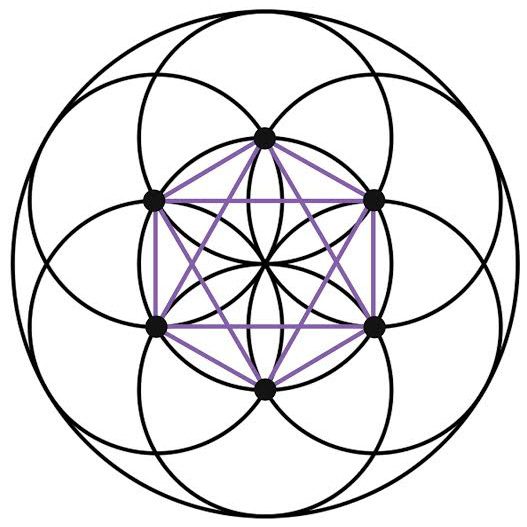 (Above: The figure we call the “Seed of Life” was used historically to construct the hexagram and hexagon. Image Source: Adaptation of a public domain image, Wikimedia Commons.)
(Above: The figure we call the “Seed of Life” was used historically to construct the hexagram and hexagon. Image Source: Adaptation of a public domain image, Wikimedia Commons.)
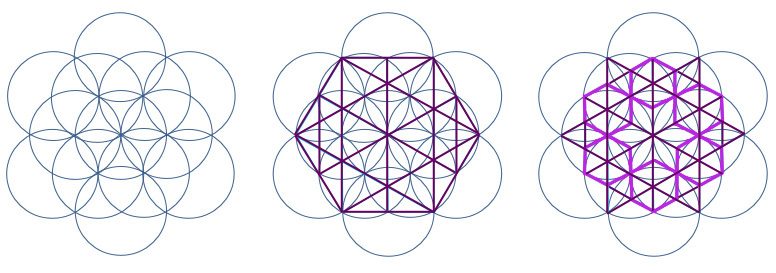
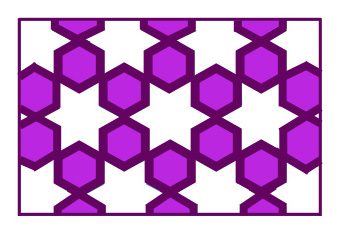 (The seven interlocking circles could also be used as a template for more complex geometric patterns, like an underlying grid in Islamic art. Image Source: Adaptation of a public domain image, Wikimedia Commons.)
(The seven interlocking circles could also be used as a template for more complex geometric patterns, like an underlying grid in Islamic art. Image Source: Adaptation of a public domain image, Wikimedia Commons.)


 (Top row, left to right: Variations on the central rosette on 17th century BCE Greek coins, an early 15th century CE Arabic tile, and the Gundestrup cauldron of Denmark. Middle row, left to right: Examples of the rosette net pattern on a 1stcentury BCE mosaic in Israel, a monastery window on Crete, and a sketch by Leonardo da Vinci. Bottom row, left to right: The rosette can be used to generate more complicated geometric patterns like the rose window of Saint Stephen’s cathedral in Vienna, a 2nd century CE Roman mosaic in France, and an early 17th century Chinese illumination for a Qu’ran. Image Source: Public domain, Wikimedia Commons.)
(Top row, left to right: Variations on the central rosette on 17th century BCE Greek coins, an early 15th century CE Arabic tile, and the Gundestrup cauldron of Denmark. Middle row, left to right: Examples of the rosette net pattern on a 1stcentury BCE mosaic in Israel, a monastery window on Crete, and a sketch by Leonardo da Vinci. Bottom row, left to right: The rosette can be used to generate more complicated geometric patterns like the rose window of Saint Stephen’s cathedral in Vienna, a 2nd century CE Roman mosaic in France, and an early 17th century Chinese illumination for a Qu’ran. Image Source: Public domain, Wikimedia Commons.)
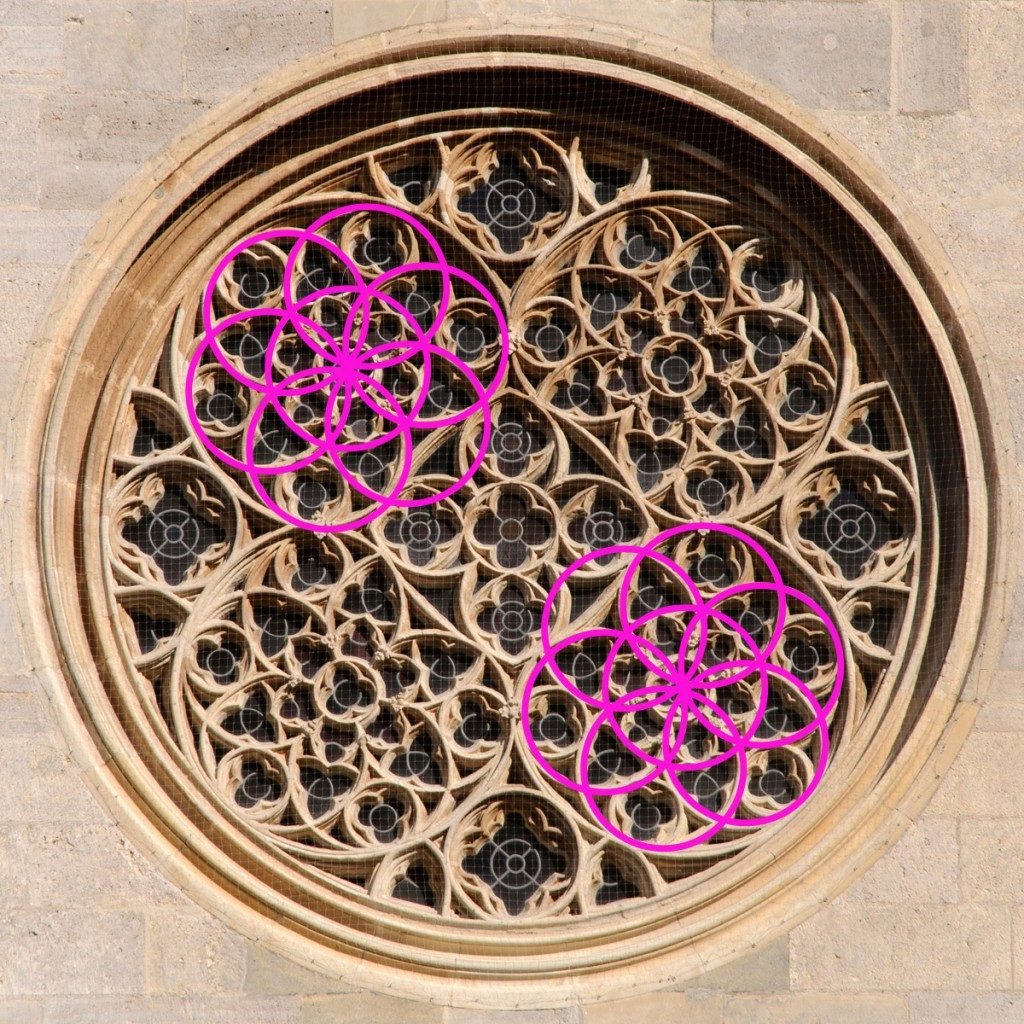 (Detail of the rose window of Saint Stephen’s cathedral in Vienna, Austria, showing the “Seed of Life” as a template for some of its tracery. The rosette often hides beneath more complicated geometric patterns. Image Source: Adaptation of a public domain image, Wikimedia Commons.)
(Detail of the rose window of Saint Stephen’s cathedral in Vienna, Austria, showing the “Seed of Life” as a template for some of its tracery. The rosette often hides beneath more complicated geometric patterns. Image Source: Adaptation of a public domain image, Wikimedia Commons.)
The Seed of Life derives much of its meaning today from the symbolism of the circle, the crossed circle (“vesica piscis”), and the numbers six and seven.
1: Circle: Mathematics was once a sacred science, believed to hold insights about both God and the natural world. Different numbers and shapes developed their own meanings. For example, the circle can represent the divine act of creation because of its use in constructing other shapes.
2: Vesica Piscis: The pointed oval between the two circles is known today as the vesica piscis, a name attributed to the 16th century German artist Albert Dürer. The Latin vesica piscis (“fish bladder”) is a translation of the German Fischblase (“fish bladder”), a term originally used in architecture for curved openings in window tracery that resemble the swim bladder of a fish.
Because the letter “c” has been vocalized differently in Latin over time, vesica piscis has a range of correct pronunciations. The piscis can be said as “pis-kis” (classical Latin, hard “k” sound) or “pis-sis” (later Latin, “s” sound). Most people today say “veh-see-kuh pis-sis” which oddly uses the original “k” sound in vesica but uses the later “s” sound in piscis.
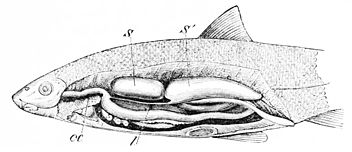
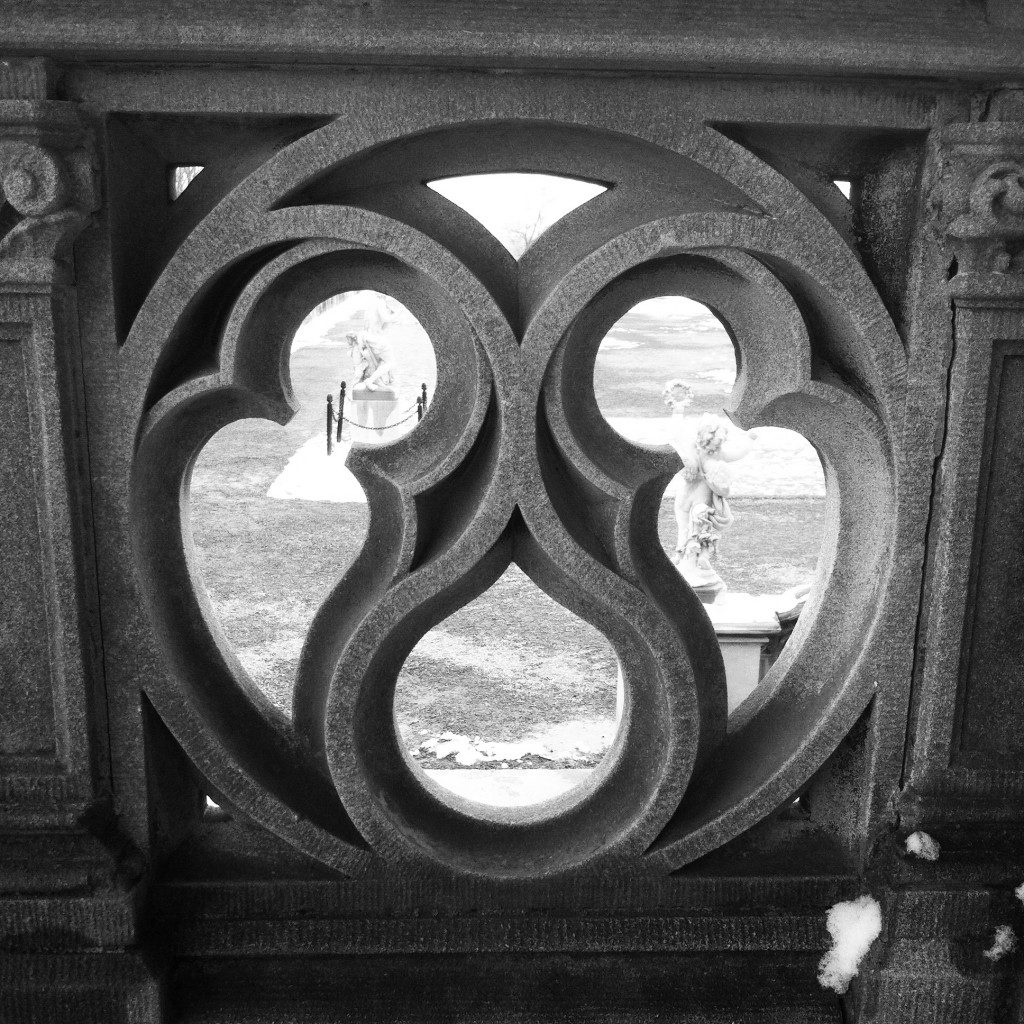 (Above: Some fish have an organ that helps them maintain their buoyancy called a swim bladder. It typically consists of two gas filled sacs connected together. A late 19th century illustration of fish anatomy. Image Source: Public domain, Wikimedia Commons. Below: A railing at the Biltmore estate in Asheville, North Carolina with a Fischblase [German, “fish bladder”] motif. This shape is better known in English as a mouchette [French, “snuffer”] when curved or souflette [French, “bellows”] when straight. Image Source: Christopher Lee Matthews.)
(Above: Some fish have an organ that helps them maintain their buoyancy called a swim bladder. It typically consists of two gas filled sacs connected together. A late 19th century illustration of fish anatomy. Image Source: Public domain, Wikimedia Commons. Below: A railing at the Biltmore estate in Asheville, North Carolina with a Fischblase [German, “fish bladder”] motif. This shape is better known in English as a mouchette [French, “snuffer”] when curved or souflette [French, “bellows”] when straight. Image Source: Christopher Lee Matthews.)
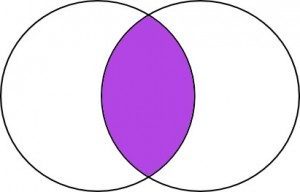
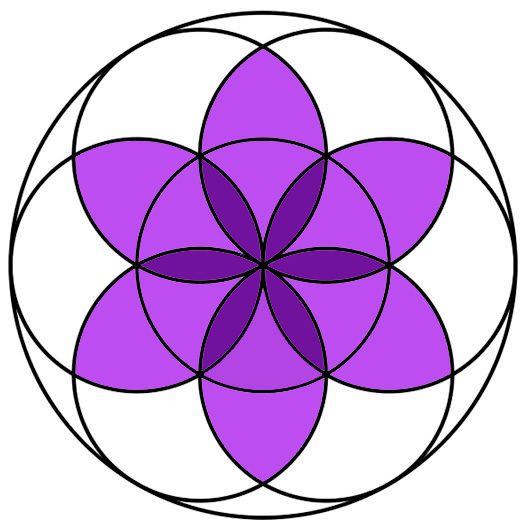
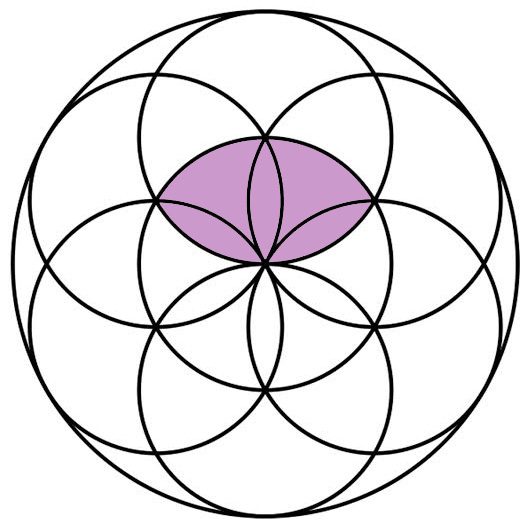 (Image Source: Adaptation of a public domain image, Wikimedia Commons.)
(Image Source: Adaptation of a public domain image, Wikimedia Commons.)
The Seed of Life has six different vesica piscis (purple), created between each neighboring circle, and an inner rosette of similar but smaller lenses (dark purple). An additional six vesica piscis are created by the center circle crossing each of the outer circles (light purple).
Many of the Seed of Life’s meanings are derived from the symbolism of the vesica piscis:
A: “The Mother of Geometry”: Some believe the vesica piscis is a symbol of the Divine Feminine, with the pointed oval signifying the vulva. Because of its traditional use in mathematics, it is also seen as the mother of geometric shapes, giving birth to the triangle, square, and other regular polygons. Figures derived from the vesica piscis, like the Seed of Life and Flower of Life, may also be used to generate geometric figures.
It also has a unique relationship to several square roots. It was used historically as a geometric proof for the square roots of 2, 3, and 5, as shown below. They are often associated with form themselves. For example, the irrational number phi was generated from the square root of 5 historically:
![]()
Phi is the foundation of the “golden ratio”, a system of proportion often used in nature to guide the growth of plants and animals.
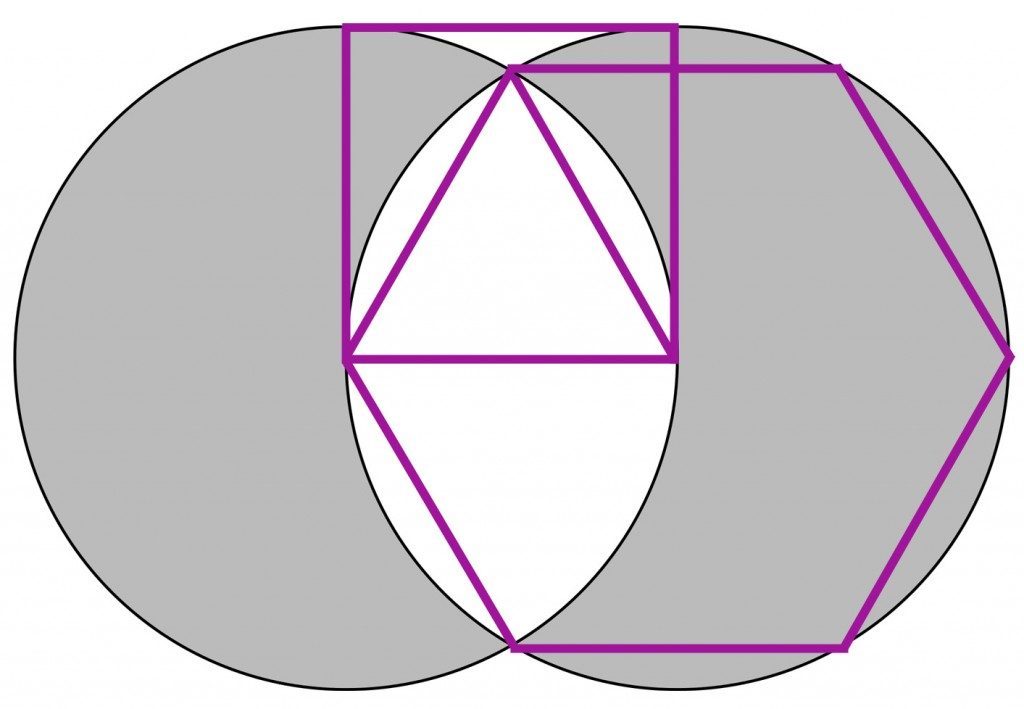 (The vesica piscis can be used to construct regular polygons like the trianlge, square, and hexagon. Image Source: Adaptation of a public domain image, Wikimedia Commons.)
(The vesica piscis can be used to construct regular polygons like the trianlge, square, and hexagon. Image Source: Adaptation of a public domain image, Wikimedia Commons.)
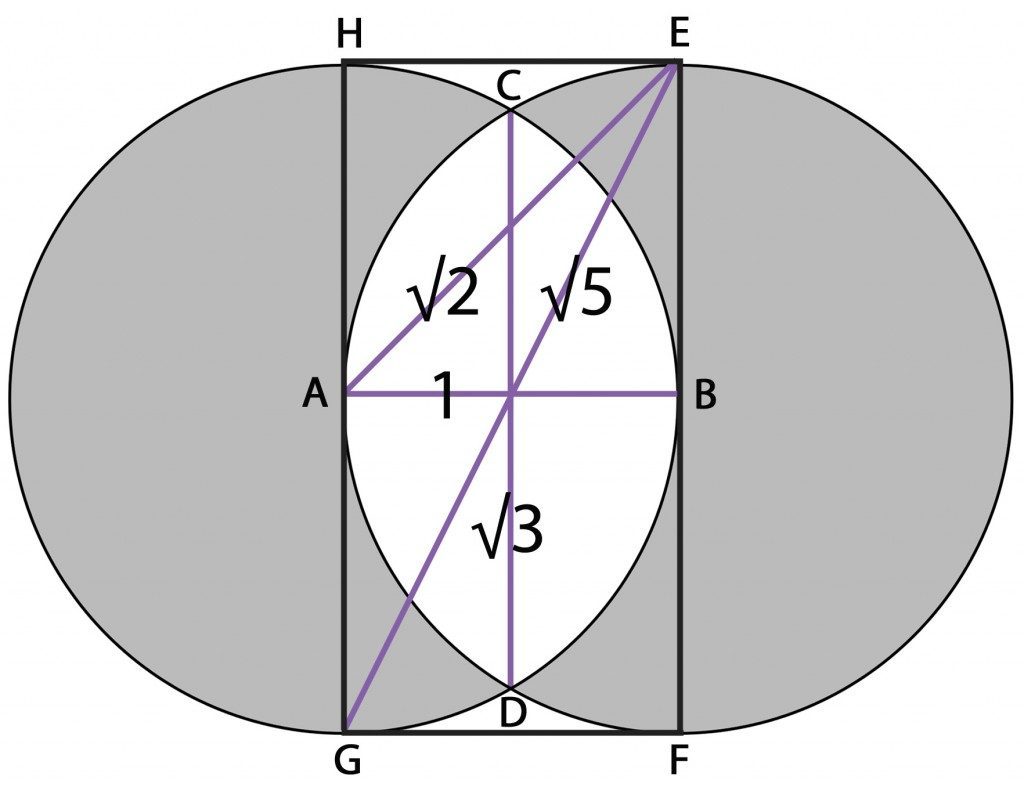 (The vesica piscis has a special relationship to three different square roots. If A to B is 1, the radius of both circles, then C to D is equal to the √3, E to G to √5, and E to A to √2. Image Source: Adaptation of a public domain image, Wikimedia Commons.)
(The vesica piscis has a special relationship to three different square roots. If A to B is 1, the radius of both circles, then C to D is equal to the √3, E to G to √5, and E to A to √2. Image Source: Adaptation of a public domain image, Wikimedia Commons.)
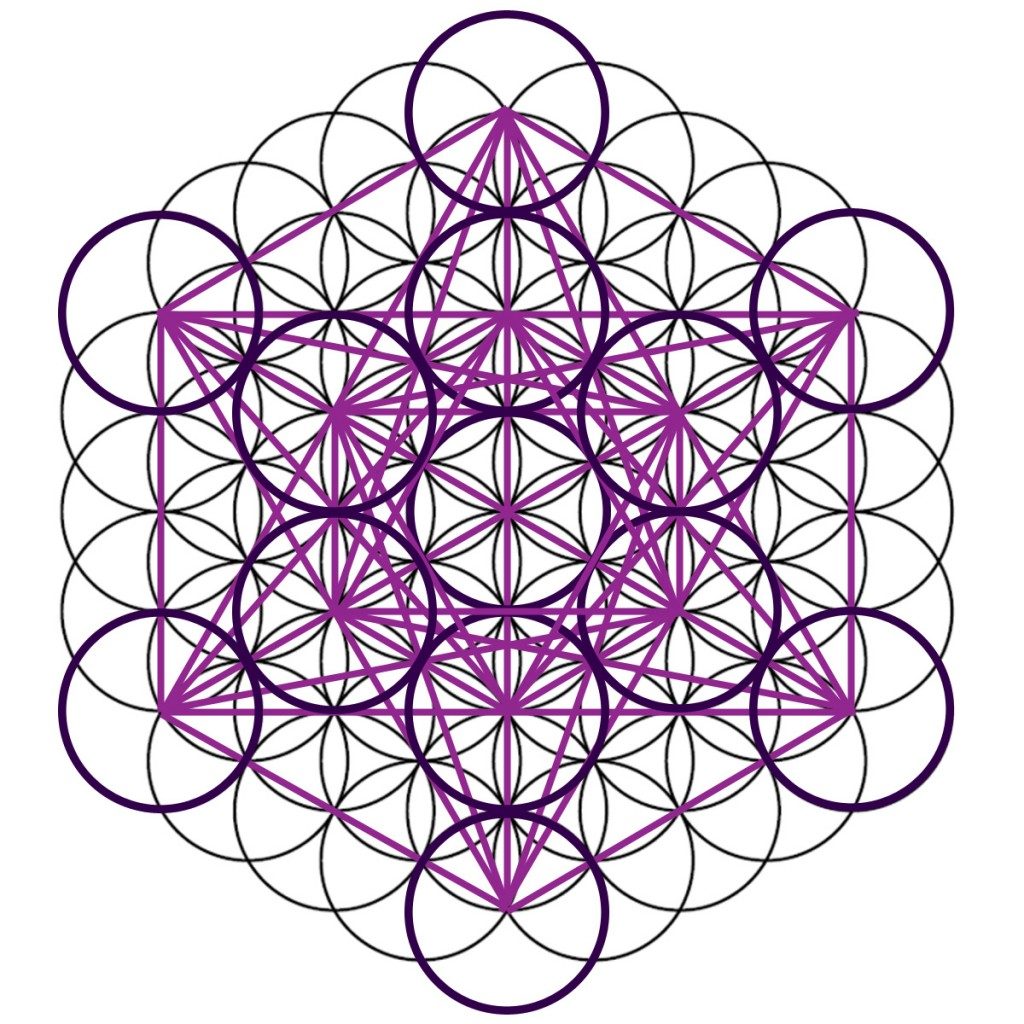 (Patterns derived from the “Seed of Life” are also used to map out geometric forms. The Flower of Life as a template for “Metatron’s Cube”, a figure that contains all five of the Platonic Solids. Image Source: Adaptation of a public domain image, Wikimedia Commons.)
(Patterns derived from the “Seed of Life” are also used to map out geometric forms. The Flower of Life as a template for “Metatron’s Cube”, a figure that contains all five of the Platonic Solids. Image Source: Adaptation of a public domain image, Wikimedia Commons.)
B: The Union of Opposites: Because the vesica piscis is created by crossing two circles, it became a symbol of the union of opposites like heaven and earth, male and female, and spirit and matter. The shape was also known historically as the mandorla (Italian, “almond”), after the shape of the nut. The mandorla was commonly used in Christian art as an aureole around religious figures like Jesus and Mary, to signify their role in bridging the divine and human realms.
The pointed oval also resembles the rough outline of a fish, an animal closely associated with Jesus in Christian thought.
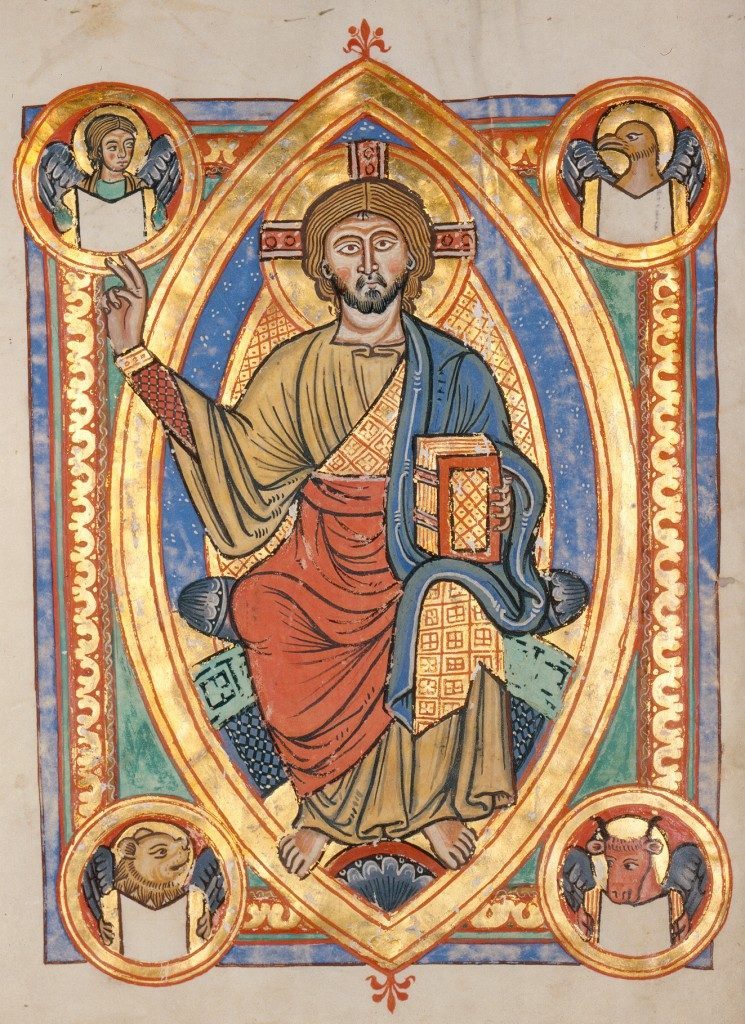 (13th century illumination of Christ in a mandorla, surrounded by an angel, eagle, bull, and lion, representing the Four Evangelists. Image Source: Public domain, Wikimedia Commons.)
(13th century illumination of Christ in a mandorla, surrounded by an angel, eagle, bull, and lion, representing the Four Evangelists. Image Source: Public domain, Wikimedia Commons.)
3: Six and Seven: The Seed of Life is paradoxically related to both the number six and seven. Therefore it has become associated with similarly organized symbols, where seven is more technically 6+1.
A: Biblical Creation: Creation lasted a week in the Bible, with God resting on the seventh day.
B: The Chakras: The modern chakra system is rooted in an originally Hindu model known as the sat cakra/shat chakra (Sanskrit, “six chakras”). Although there are actually seven chakras, the Crown Chakra above the head was seen as so radically different than the others, it was not included in the count.
C: The Planets: Because of the central importance and size of the Sun, sometimes the seven classical planets (Sun, Moon, Mercury, Venus, Mars, Jupiter, Saturn) are symbolically represented as 6 + 1.
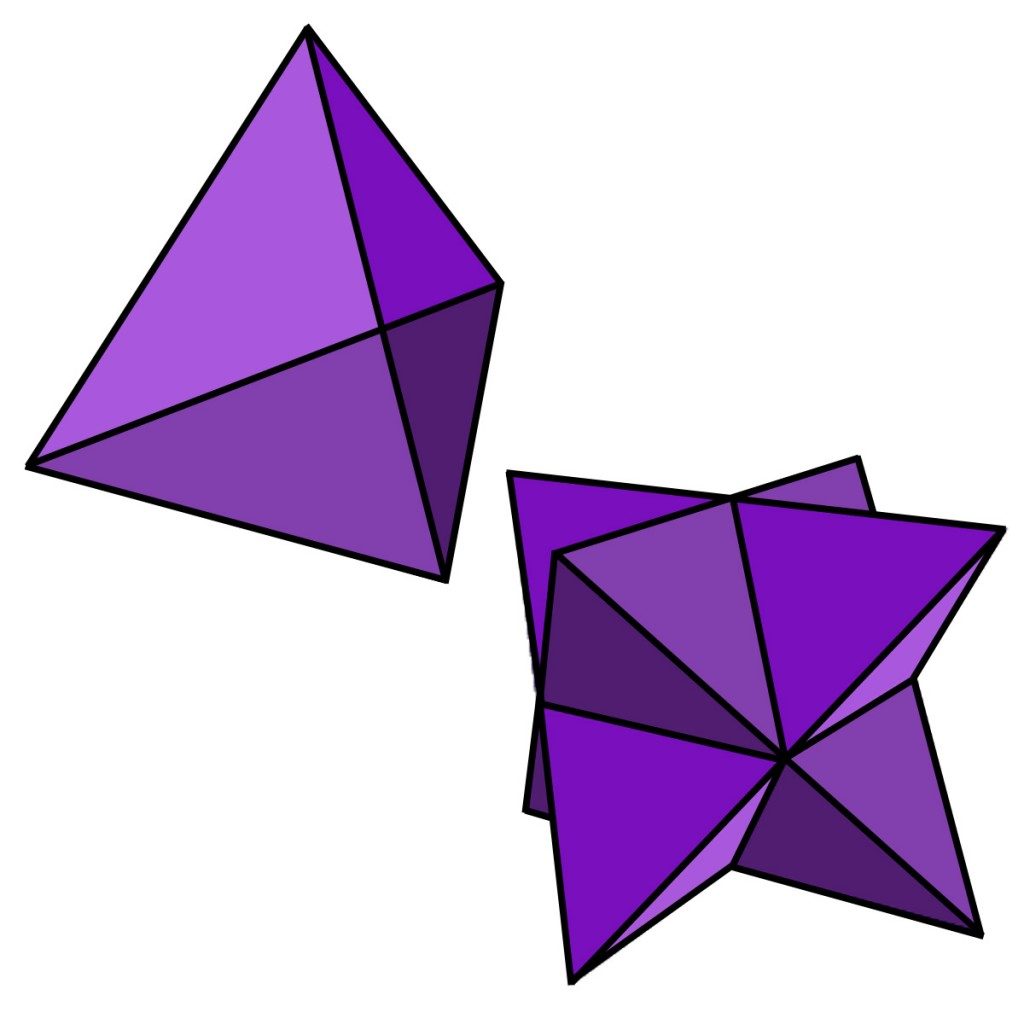 (The stellated octahedron [right] is better known in the metaphysical community as the “Merkaba”. The shape is created by crossing two tetrahedrons [left]. The tetrahedron is similar to a pyramid but constructed from four triangles rather than four triangles and a square. Image Source: Adaptation of a public domain image, Wikimedia Commons.)
(The stellated octahedron [right] is better known in the metaphysical community as the “Merkaba”. The shape is created by crossing two tetrahedrons [left]. The tetrahedron is similar to a pyramid but constructed from four triangles rather than four triangles and a square. Image Source: Adaptation of a public domain image, Wikimedia Commons.)
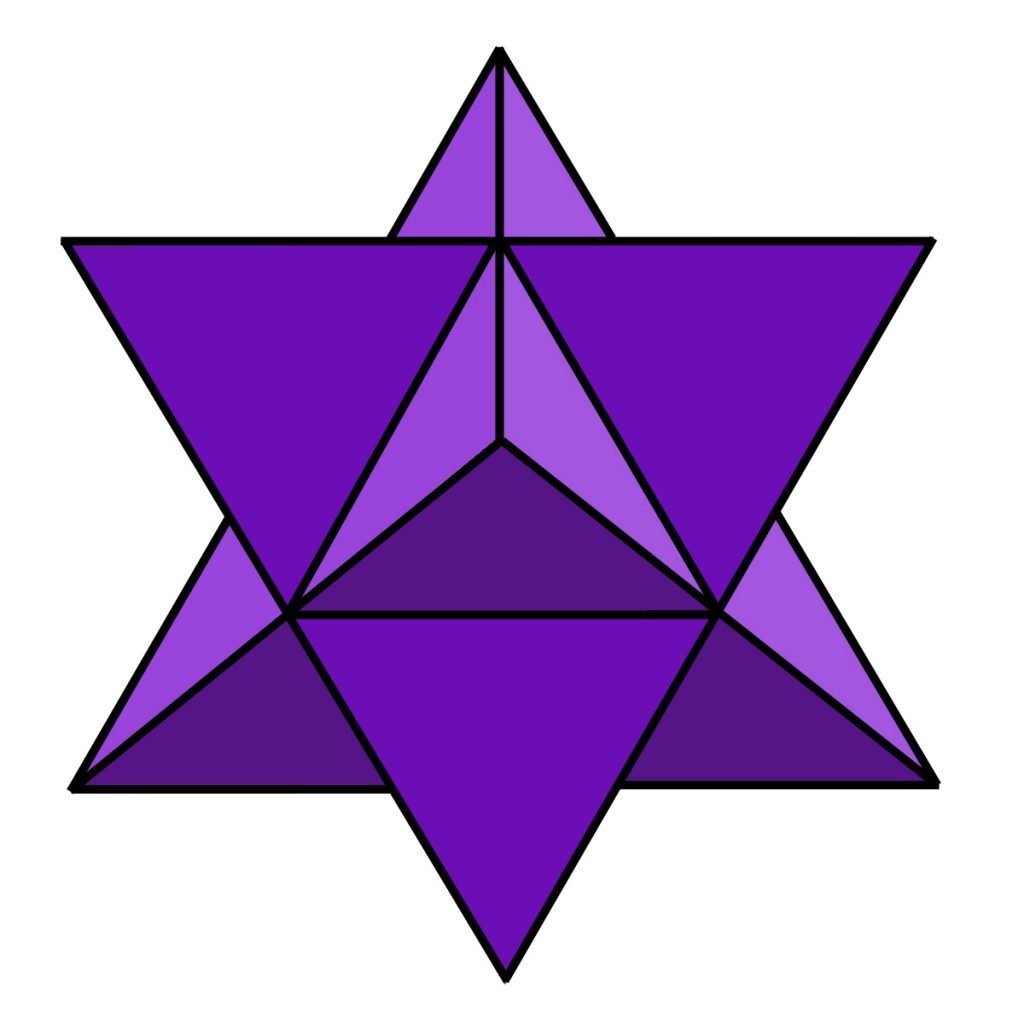 (The stellated octahedron is often represented as standing on one of its points in contemporary sources. Image Source: Adaptation of a public domain image, Wikimedia Commons.)
(The stellated octahedron is often represented as standing on one of its points in contemporary sources. Image Source: Adaptation of a public domain image, Wikimedia Commons.)
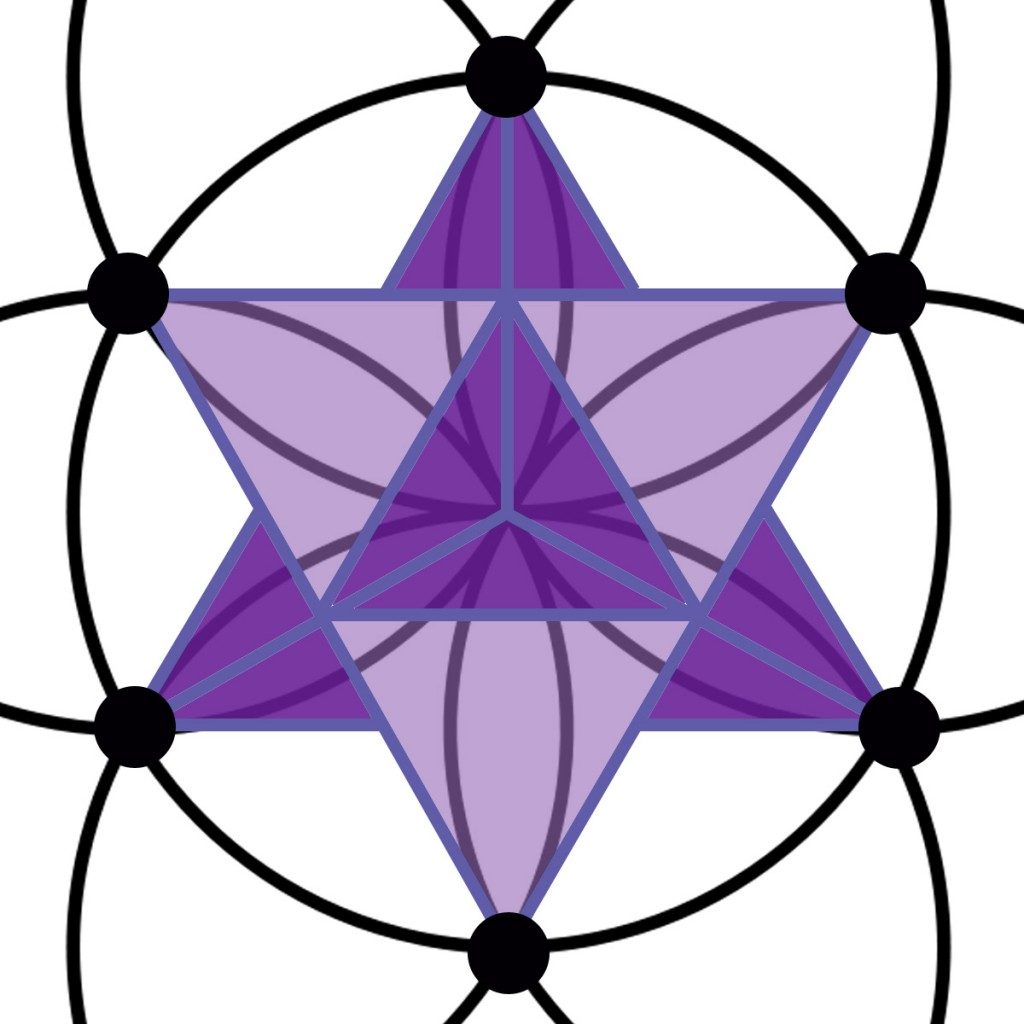
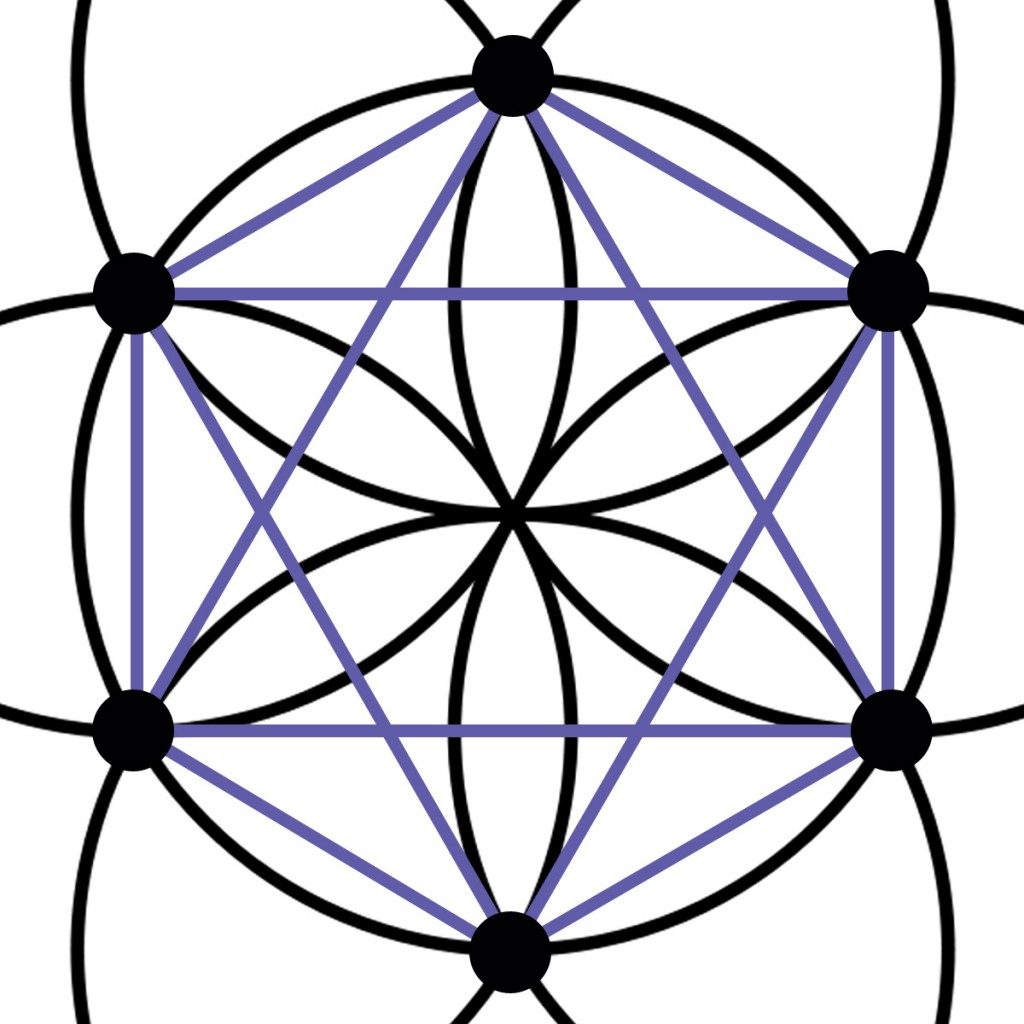
(The “Seed of Life”, “Flower of Life”, and “Merkaba” are all derived from the same six sided geometry. Image Source: Adaptation of a public domain image, Wikimedia Commons.)
D: The Merkaba: Like the “Seed of Life” and “Flower of Life”, the “Merkaba” is a contemporary name for an ancient geometric figure, popularized by the author Drunvalo Melchizedek. It is the three dimensional equivalent of the hexagram, created by crossing two tetrahedron. All three figures are derived from the same six sided geometry.
Although commonly described as a “star tetrahedron”, it is actually a stellated octahedron instead. Stellated figures are created by extending the faces of a polygon, producing a new pointed shape where they meet. Neither the cube nor the tetrahedron can star. When the octahedon is stellated, the eight sided figure becomes a star with eight faces and extended points instead , produced by two interpenetrating tetrahedra.
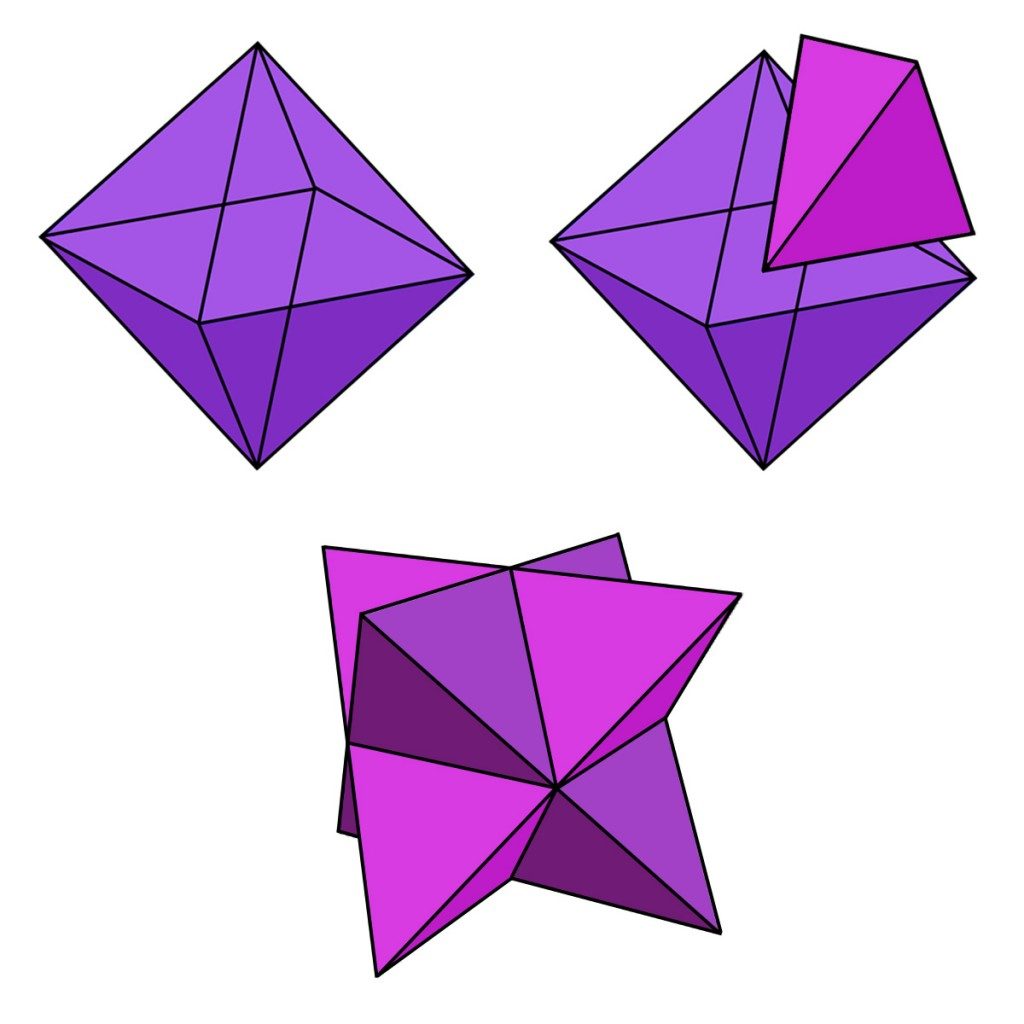
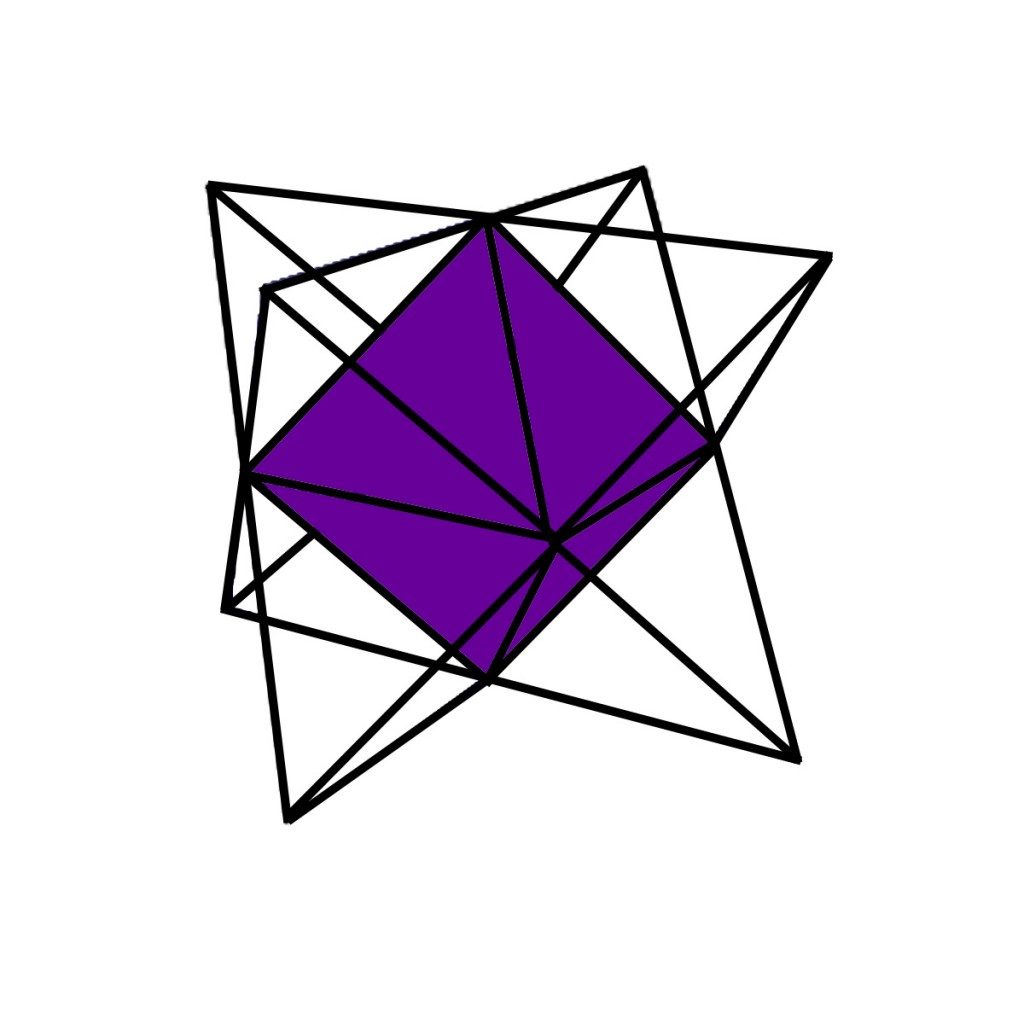 (The octahedron [above left] is a regular polygon, constructed from eight equilateral triangles. A star octahedron is created by extending the faces of the octahedron [above right], transforming the eight sided figure into a star with eight extended points instead [bottom]. Image Source: Adaptation of a public domain image, Wikimedia Commons.)
(The octahedron [above left] is a regular polygon, constructed from eight equilateral triangles. A star octahedron is created by extending the faces of the octahedron [above right], transforming the eight sided figure into a star with eight extended points instead [bottom]. Image Source: Adaptation of a public domain image, Wikimedia Commons.)
The term comes from the Hebrew merkaba/merkava, meaning “chariot”. The word originally referred to the moving throne of God in the Bible, like the vision of Ezekiel, and spiritual practices based upon it historically. The metaphysical Merkaba is a restructuring of the energy body, represented as a series of spinning stellated octahedrons. It is said to be aligned with the main chakras along the spine, terminating at a point above the crown chakra and below the feet chakras. Other details like the orientation of the points, the number of merkabas, and the directionality of their spin differ between sources.
The Seed of Life, Flower of Life, and the Merkaba have all become major symbols of personal and collective evolution within today’s renaissance of sacred geometry.
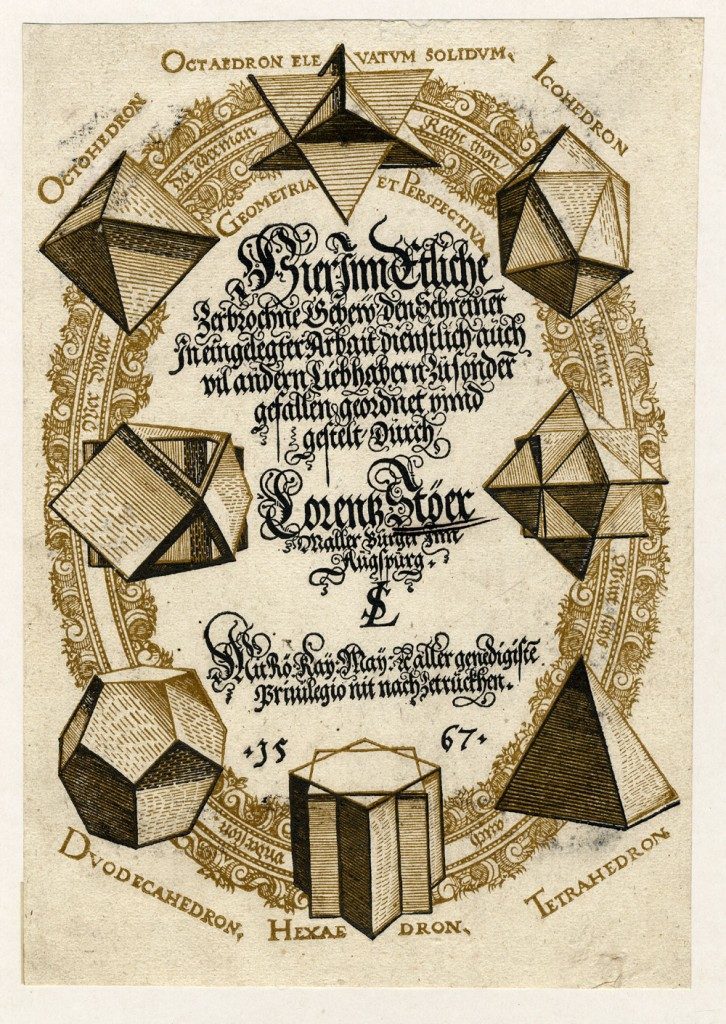 (Above: 16th century woodcut of geometric figures by Lorenz Stoer. Front piece of “Geometry and Perspective” with four of the five Platonic Solids [tetrahedron, octahedron, dodecahedron, and icosahedron] in the corners and four irregular solids between them, including a stellated octahedron at the top. Image Source: Public domain, Wikimedia Commons. Below:
(Above: 16th century woodcut of geometric figures by Lorenz Stoer. Front piece of “Geometry and Perspective” with four of the five Platonic Solids [tetrahedron, octahedron, dodecahedron, and icosahedron] in the corners and four irregular solids between them, including a stellated octahedron at the top. Image Source: Public domain, Wikimedia Commons. Below:
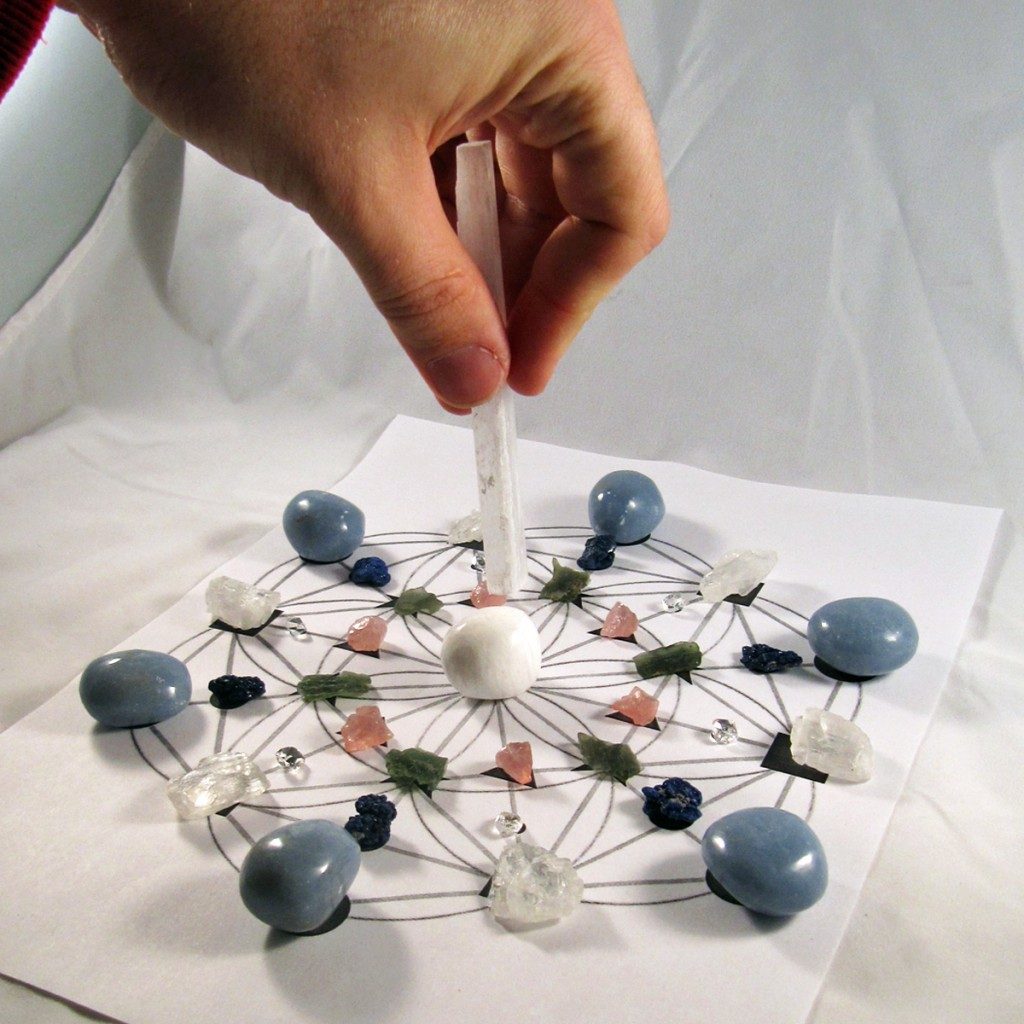
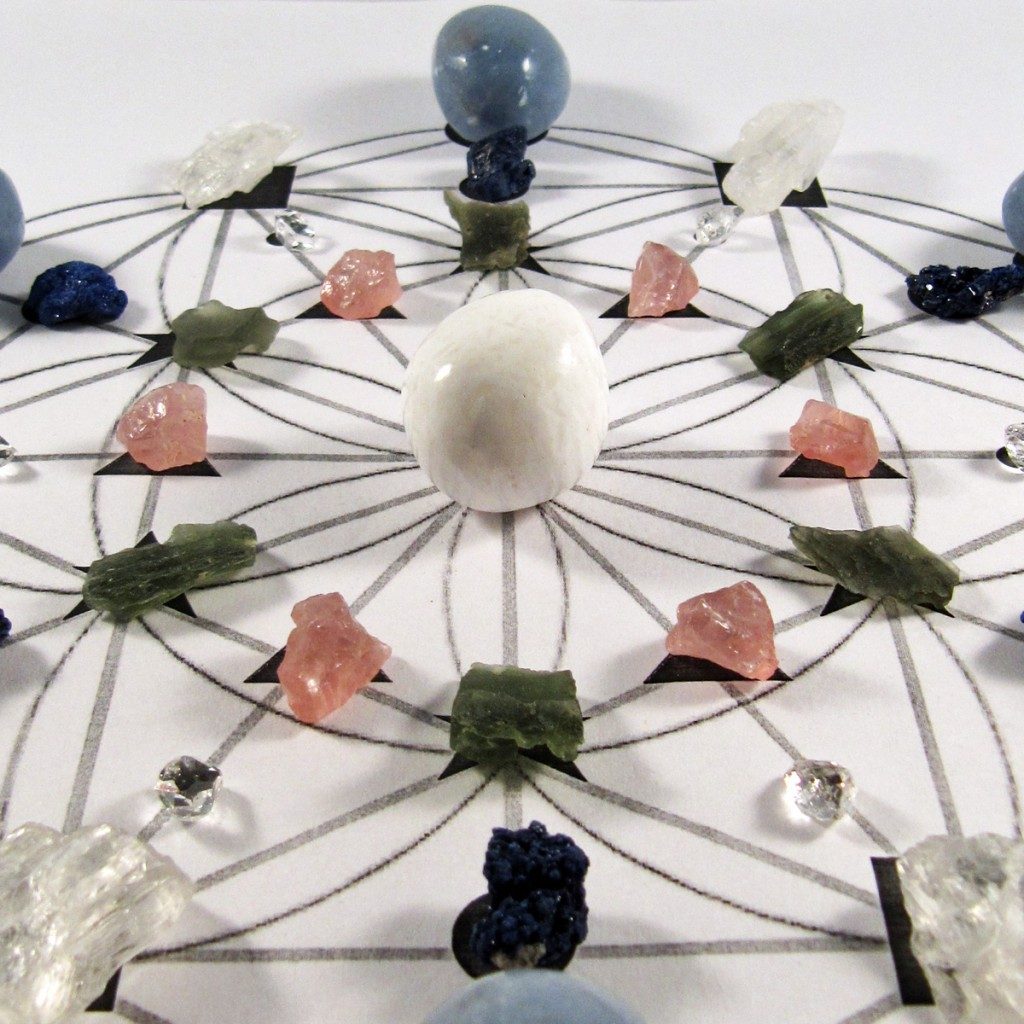 (A grid to support higher consciousness with scolecite, Moldavite tektite, rose quartz, Herkimer Diamond quartz, azurite, petalite, and angelite. Image Source: Christopher Lee Matthews
(A grid to support higher consciousness with scolecite, Moldavite tektite, rose quartz, Herkimer Diamond quartz, azurite, petalite, and angelite. Image Source: Christopher Lee Matthews
©2020 Christopher Lee Matthews, Enter the Earth. See more interesting blog articles and amazing crystals and rocks at Enter the Earth. Don’t forget to follow us on Instagram!
